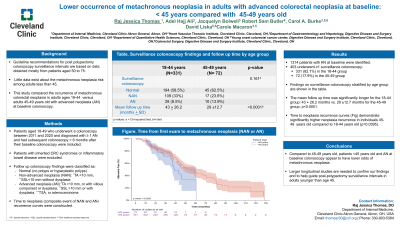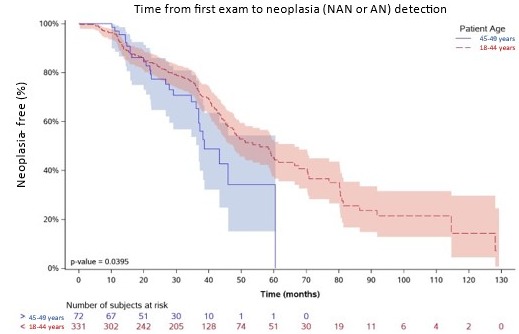Monday Poster Session
Category: Colorectal Cancer Prevention
P1763 - Risk of Metachronous Neoplasia in Adults Younger Than Age 49 With Advanced Neoplasia on Baseline Colonoscopy: A Comparison of <45 Years vs 45-49 Years of Age
Monday, October 23, 2023
10:30 AM - 4:15 PM PT
Location: Exhibit Hall

Has Audio

Raj Jessica Thomas, DO
Cleveland Clinic
Cleveland, OH
Presenting Author(s)
Adel Haj Ali, MD1, Raj Jessica Thomas, DO1, Jacquelyn Bolwell, MD2, Robert S. Butler, MS2, Carol A. Burke, MD, FACG2, Carole Macaron, MD1
1Cleveland Clinic, Cleveland, OH; 2Cleveland Clinic Foundation, Cleveland, OH
Introduction: Guideline recommendations for post polypectomy colonoscopy surveillance intervals are based on data obtained mostly from patients ages 50 to 75. Little data exist about the metachronous neoplasia risk among adults less than 45. The study aims to compare the risk of metachronous colorectal neoplasia in adults ages 18-44 years versus adults 45-49 years old who had advanced neoplasia (AN) at baseline colonoscopy.
Methods: All patients 18-49 years of age who underwent a colonoscopy at our center between 2011 and 2020 and diagnosed with ≥ 1 AN [tubular adenoma (TA) >10 mm or with villous features or high-grade dysplasia (HGD), sessile serrated lesion (SSL) >10 mm or with dysplasia, traditional serrated adenoma (TSA) or invasive adenocarcinoma] and had subsequent colonoscopy > 6 months after their baseline colonoscopy were included. Patients with inherited CRC syndromes or inflammatory bowel disease were excluded. Patients were categorized based on age at baseline colonoscopy:18-44 years versus 45-49 years. Outcomes were classified into findings of metachronous neoplasia on follow up colonoscopy: 1) normal (no polyps or hyperplastic polyps), 2) non-advanced neoplasia (NAN) [tubular adenoma (TA) < 10 mm, sessile serrated lesion (SSL)< 10 mm without dysplasia], and 3) AN. Time to occurrence of metachronous neoplasia (composite of NAN and AN) curves were constructed. Log-rank test was used to compare the curves.
Results: 1314 patients with AN at baseline were identified. 403 underwent ≥1 surveillance colonoscopy: 331 (82.1%) in the 18-44 group and 72 (17.9%) in the 45-49 group. The mean follow- up time was longer for the 18-44 group versus the 45–49-year-olds (43 + 26.2 months vs. 29 ±12.7 months respectively, p< 0.0001). Surveillance colonoscopy was normal in 239 patients (59.4%):194 (58.5%) in the 18-44 group versus 45 (62.5%) in the 45-49 group. NAN was diagnosed in 126 (31.3%):109 (33%) in the 18-44 group versus 17 (23.6%) in the 45-49 group] and AN in 38 (9.3%) :28 (8.5%) in the 18-44 group versus 10 (13.9%) in the 45-49 group] (Table). Time to metachronous neoplasia curves (Fig 1) demonstrate significantly higher rates of neoplasia recurrence in individuals 45-49 compared to 18-44 years old (p=0.0395).
Discussion: Metachronous neoplasia was significantly lower in adults with AN at baseline that are younger than age 45 compared to 45-49 years old, suggesting a reduced risk for future lesions. The results of our study support lengthening surveillance interval in this age group.

Disclosures:
Adel Haj Ali, MD1, Raj Jessica Thomas, DO1, Jacquelyn Bolwell, MD2, Robert S. Butler, MS2, Carol A. Burke, MD, FACG2, Carole Macaron, MD1. P1763 - Risk of Metachronous Neoplasia in Adults Younger Than Age 49 With Advanced Neoplasia on Baseline Colonoscopy: A Comparison of <45 Years vs 45-49 Years of Age, ACG 2023 Annual Scientific Meeting Abstracts. Vancouver, BC, Canada: American College of Gastroenterology.
1Cleveland Clinic, Cleveland, OH; 2Cleveland Clinic Foundation, Cleveland, OH
Introduction: Guideline recommendations for post polypectomy colonoscopy surveillance intervals are based on data obtained mostly from patients ages 50 to 75. Little data exist about the metachronous neoplasia risk among adults less than 45. The study aims to compare the risk of metachronous colorectal neoplasia in adults ages 18-44 years versus adults 45-49 years old who had advanced neoplasia (AN) at baseline colonoscopy.
Methods: All patients 18-49 years of age who underwent a colonoscopy at our center between 2011 and 2020 and diagnosed with ≥ 1 AN [tubular adenoma (TA) >10 mm or with villous features or high-grade dysplasia (HGD), sessile serrated lesion (SSL) >10 mm or with dysplasia, traditional serrated adenoma (TSA) or invasive adenocarcinoma] and had subsequent colonoscopy > 6 months after their baseline colonoscopy were included. Patients with inherited CRC syndromes or inflammatory bowel disease were excluded. Patients were categorized based on age at baseline colonoscopy:18-44 years versus 45-49 years. Outcomes were classified into findings of metachronous neoplasia on follow up colonoscopy: 1) normal (no polyps or hyperplastic polyps), 2) non-advanced neoplasia (NAN) [tubular adenoma (TA) < 10 mm, sessile serrated lesion (SSL)< 10 mm without dysplasia], and 3) AN. Time to occurrence of metachronous neoplasia (composite of NAN and AN) curves were constructed. Log-rank test was used to compare the curves.
Results: 1314 patients with AN at baseline were identified. 403 underwent ≥1 surveillance colonoscopy: 331 (82.1%) in the 18-44 group and 72 (17.9%) in the 45-49 group. The mean follow- up time was longer for the 18-44 group versus the 45–49-year-olds (43 + 26.2 months vs. 29 ±12.7 months respectively, p< 0.0001). Surveillance colonoscopy was normal in 239 patients (59.4%):194 (58.5%) in the 18-44 group versus 45 (62.5%) in the 45-49 group. NAN was diagnosed in 126 (31.3%):109 (33%) in the 18-44 group versus 17 (23.6%) in the 45-49 group] and AN in 38 (9.3%) :28 (8.5%) in the 18-44 group versus 10 (13.9%) in the 45-49 group] (Table). Time to metachronous neoplasia curves (Fig 1) demonstrate significantly higher rates of neoplasia recurrence in individuals 45-49 compared to 18-44 years old (p=0.0395).
Discussion: Metachronous neoplasia was significantly lower in adults with AN at baseline that are younger than age 45 compared to 45-49 years old, suggesting a reduced risk for future lesions. The results of our study support lengthening surveillance interval in this age group.

Figure: Cumulative metachronous neoplasia-free rates (composite of NAN and AN) by age group.
Disclosures:
Adel Haj Ali indicated no relevant financial relationships.
Raj Jessica Thomas indicated no relevant financial relationships.
Jacquelyn Bolwell indicated no relevant financial relationships.
Robert Butler indicated no relevant financial relationships.
Carol Burke: ambry – Speakers Bureau. emtora – Grant/Research Support. freenome – Grant/Research Support. guardant – Advisory Committee/Board Member. sebela – Consultant.
Carole Macaron: EMTORA BIOSCIENCES – COINVESTIGATOR ON A RESEARCH STUDY SUPPORTED BY EMTORA.
Adel Haj Ali, MD1, Raj Jessica Thomas, DO1, Jacquelyn Bolwell, MD2, Robert S. Butler, MS2, Carol A. Burke, MD, FACG2, Carole Macaron, MD1. P1763 - Risk of Metachronous Neoplasia in Adults Younger Than Age 49 With Advanced Neoplasia on Baseline Colonoscopy: A Comparison of <45 Years vs 45-49 Years of Age, ACG 2023 Annual Scientific Meeting Abstracts. Vancouver, BC, Canada: American College of Gastroenterology.
